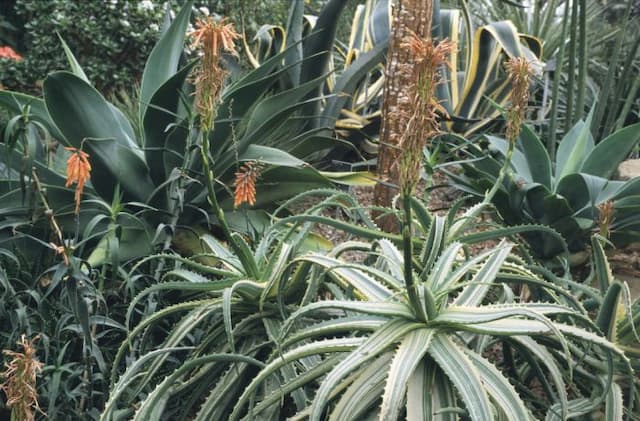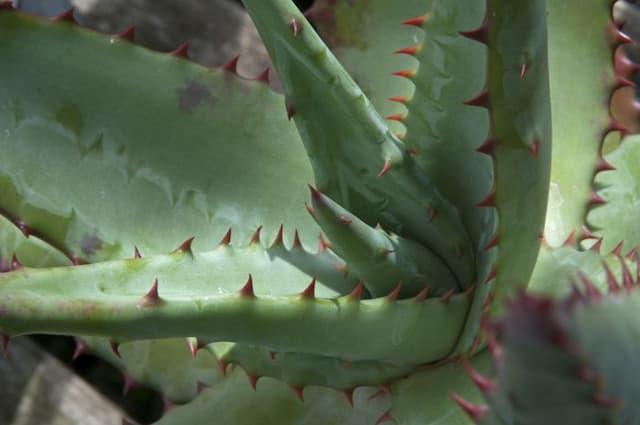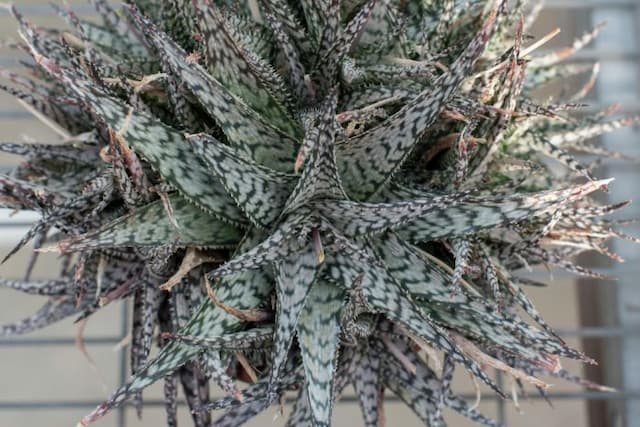Red Hot Poker Kniphofia 'Little Maid'

ABOUT
The plant commonly known as 'Little Maid' is part of the Red Hot Poker family and is admired for its unique flower spikes. It carries a striking appearance characterized by clumps of arching, grass-like, green foliage. Rising above this verdant tuft of leaves are the showy flower spikes that give the plant its common name. These cylindrical flower heads start off as a creamy white color at the base, transitioning into a soft yellow hue toward the tips, evoking a gentle two-tone effect. The blossoms are densely packed on the sturdy stems, like little torches held aloft, and they bloom progressively from the bottom to the top. The plant also has a coarse texture that comes from the rough-edged leaves, adding a tactile dimension to its appearance. When in bloom, the plant brings a warm, luminous quality to garden spaces, drawing the eye with its radiant flowering torches.
About this plant
 Names
NamesSynonyms
Red Hot Poker, Torch Lily, Poker Plant
Common names
Kniphofia 'Little Maid'.
 Toxicity
ToxicityTo humans
Red Hot Poker (Kniphofia 'Little Maid') is not commonly listed as a toxic plant to humans. However, as with many plants not typically thought of as toxic, individual reactions can occur, and it is generally recommended to avoid ingestion. If you suspect someone has ingested this plant, and they are showing symptoms of distress, seek medical attention.
To pets
Red Hot Poker (Kniphofia 'Little Maid') is not generally recognized as a toxic plant to pets. However, the consumption of any plant material may cause vomiting and gastrointestinal upset for dogs and cats. If your pet has ingested this plant, keep an eye on the animal and contact your veterinarian if any worrisome symptoms develop.
 Characteristics
CharacteristicsLife cycle
Perennials
Foliage type
Evergreen
Color of leaves
Green
Flower color
Yellow
Height
2 feet (0.6 meters)
Spread
1 foot (0.3 meters)
Plant type
Bulb
Hardiness zones
6
Native area
South Africa
Benefits
 General Benefits
General Benefits- Attracts Pollinators: Kniphofia 'Little Maid' is known for attracting bees, butterflies, and other beneficial insects to the garden.
- Drought Tolerant: Once established, the plant is relatively low maintenance and can tolerate periods with less water, suitable for xeriscaping.
- Deer Resistant: The plant is not favored by deer, which makes it a good choice for gardens in areas with deer populations.
- Long Blooming: Kniphofia 'Little Maid' provides a long season of blooms, typically from early to late summer.
- Architectural Interest: With its tall flower spikes and grass-like foliage, it adds vertical interest to a garden design.
- Color Impact: The creamy white to yellow blooms add a soft yet striking color effect in a garden scheme.
- Easy to Grow: It is generally a hardy plant that doesn't require much specialist care once settled in an appropriate environment.
 Medical Properties
Medical PropertiesThis plant is not used for medical purposes.
 Air-purifying Qualities
Air-purifying QualitiesThis plant is not specifically known for air purifying qualities.
 Other Uses
Other Uses- Textile Dyeing: The juice extracted from the flowers of the Red Hot Poker can be used as a natural dye for textiles, imparting a range of yellow or green hues depending on the mordant used.
- Photography: The distinct shape and vibrant colors of Red Hot Poker flowers can be used by photographers as an eye-catching subject for practicing macro photography techniques.
- Garden Themed Artwork: Artists may use the form of this plant as inspiration in sculptures and garden installations, making it a part of a larger artistic expression.
- Educational Tool: Botany educators can use the Red Hot Poker to teach students about pollination, as it attracts hummingbirds, bees, and butterflies.
- Fire Retardant Landscaping: When planted in masses, Red Hot Pokers can be part of a fire-retardant garden design due to their high moisture content.
- Seasonal Celebrations: Red Hot Poker blooms can be used in floral arrangements for autumnal events due to their late blooming season and warm, fiery colors.
- Companion Planting: The Red Hot Poker can be used in companion planting to benefit other plants, as it can attract pollinators and sometimes deter pests.
- Culinary Decoration: Although not commonly consumed, the flowers can be used as a decorative element for plating in high-end culinary presentations.
- Marker Plant: In large gardens, the tall and striking appearance of the Red Hot Poker can serve as a natural marker for visitors or as a point of orientation.
- Craft Projects: Dried Red Hot Poker flowers can be used in craft projects, such as making natural potpourri or for flower pressing activities.
Interesting Facts
 Feng Shui
Feng ShuiThe Red Hot Poker is not used in Feng Shui practice.
 Zodiac Sign Compitability
Zodiac Sign CompitabilityThe Red Hot Poker is not used in astrology practice.
 Plant Symbolism
Plant Symbolism- Fiery Appearance: Kniphofia, commonly known as Red Hot Poker, often symbolizes a strong and vibrant energy, much like its bold and bright flower spikes that resemble a flaming torch.
- Attraction: The vivid blooms of the Red Hot Poker are used to symbolize attraction, as they draw in hummingbirds and pollinators, representing the magnetic pull one individual can have on another.
- Stimulation: Due to its intense color and shape, the Red Hot Poker could symbolize stimulation or excitement, reflecting the stimulating effect it can have on an environment or a person's mood.
 Water
WaterThe Red Hot Poker ('Little Maid') should be watered deeply and allowed to dry out between waterings. During the growing season, ensure it receives about an inch of water per week. In the absence of rainfall, supplement with additional water by pouring directly at the base of the plant to avoid wetting the foliage, which can lead to fungal diseases. During the winter months, reduce watering as the plant enters dormancy. Overwatering can result in root rot, so adjust your watering based on the soil moisture level.
 Light
LightRed Hot Poker thrives in full sun, meaning at least 6 hours of direct sunlight each day. Position it in a spot where daylight is abundant and unobstructed to promote the best flowering. However, in regions with extremely hot summers, it can benefit from afternoon shade to prevent scorching.
 Temperature
TemperatureRed Hot Poker is hardy and can tolerate a wide range of temperatures. It can survive in temperatures as low as 20°F and as high as 90°F. To ensure robust growth, maintain temperatures around 60°F to 75°F, which are ideal conditions for this plant.
 Pruning
PruningPrune Red Hot Poker to remove spent flower spikes and encourage new blooms. Also, in early spring or late fall, prune back any dead or damaged foliage to maintain plant health and aesthetics. The best time for a more thorough pruning is in the spring before new growth begins.
 Cleaning
CleaningAs needed
 Soil
SoilRed Hot Poker 'Little Maid' thrives in well-draining soil with a pH range of 6.0 to 7.0. A mix of garden soil, compost, and coarse sand is ideal to ensure proper drainage and fertility.
 Repotting
RepottingRed Hot Poker 'Little Maid' should be repotted every 2-3 years, or as necessary when the plant outgrows its current container.
 Humidity & Misting
Humidity & MistingRed Hot Poker 'Little Maid' tolerates a wide range of humidity levels and does not require any special humidity conditions to thrive.
 Suitable locations
Suitable locationsIndoor
Place in bright light, avoid overwatering, and provide good air circulation.
Outdoor
Plant in full sun, well-drained soil, and protect from severe frosts.
Hardiness zone
6-9 USDA
 Life cycle
Life cycleRed Hot Poker 'Little Maid' begins its life cycle with germination, where seeds sprout and establish a root system. Following germination, the plant enters the vegetative growth phase, during which it produces foliage and matures over a period of months or years, dependent on environmental conditions. The perennial nature of 'Little Maid' means that each growing season is marked by the emergence of new foliage from the base of the plant. Upon reaching maturity, Red Hot Poker 'Little Maid' starts its reproductive phase during the warmer months, typically producing tall flower spikes with pale yellow flowers that attract pollinators. After pollination, seeds develop which can be dispersed to give rise to new plants, perpetuating the cycle. Outside of active growth and flowering, the plant goes dormant during the cold season, conserving energy for the following spring's growth cycle.
 Propogation
PropogationPropogation time
Spring to Summer
The most popular method of propagation for the Torch Lily 'Little Maid' is through division. This process is ideally performed in the spring, just as the plant is coming out of dormancy and beginning to show new growth. To divide a Torch Lily, you would carefully lift the clump from the ground with a spade, making sure to keep a good amount of roots intact with each section. Then, use a sharp knife or spade to split the clump into smaller divisions, ensuring each has at least one growth point or fan of leaves. These divisions can then be replanted into well-draining soil, spaced about 18 inches (approximately 45 centimeters) apart to allow enough room for growth. Adequate watering after replanting is crucial to help the newly divided plants establish in their new locations.









